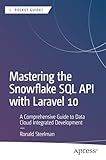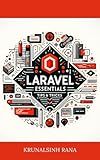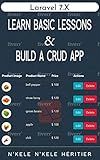Best Laravel Tools to Buy in January 2026

Laravel: Up & Running: A Framework for Building Modern PHP Apps



Mastering Laravel for Beginners: A Step-by-Step Guide to Modern PHP Development



Laravel 12 for Beginners & Beyond: A Complete Guide to Building Modern PHP Web Applications with Clean Architecture, Hands-On Projects, and Best Practices



Mastering the Snowflake SQL API with Laravel 10: A Comprehensive Guide to Data Cloud Integrated Development (Apress Pocket Guides)



The Laravel Survival Guide: Written & Updated for Laravel 5.3



Laravel Essentials: Tips & Tricks for Developers: Master Laravel with Practical Tips for Every Developer



Laravel 7.X : LEARN BASIC LESSONS & BUILD A CRUD APP (PHP Framework)


To get distinct rows in Laravel, you can use the distinct() method on your query builder. This method will only retrieve rows with unique values for the specified column or columns. For example:
$distinctRows = DB::table('users')->select('name')->distinct()->get();
This query will return only distinct rows based on the name column in the users table. You can also use the distinct() method with multiple columns:
$distinctRows = DB::table('users')->select('name', 'email')->distinct()->get();
This query will return only distinct rows based on both the name and email columns in the users table. In this way, you can easily get distinct rows in Laravel using the distinct() method on your query builder.
What is the use of distinct keyword in Laravel's query builder?
The DISTINCT keyword in Laravel's query builder is used to eliminate duplicate records from the result set. It is used in conjunction with the select method to retrieve only unique rows based on the specified column(s). This can be useful in scenarios where you want to retrieve a list of unique values from a table or when you want to avoid duplicate data in the result set.
What is the benefit of fetching unique rows in Laravel applications?
Fetching unique rows in Laravel applications can benefit a developer in the following ways:
- Efficient data retrieval: Fetching unique rows reduces the amount of data being queried from the database, which can lead to faster and more efficient data retrieval.
- Improved performance: By fetching only unique rows, the application can avoid processing duplicate data, resulting in improved performance and reduced load on the server.
- Data integrity: Ensuring unique rows are fetched can help maintain data integrity and prevent issues such as duplicate entries or inconsistent data.
- Enhanced user experience: Fetching unique rows can help present clean and organized data to users, making it easier for them to navigate and understand the information.
- Simplified data processing: Working with unique rows can simplify data processing, analysis, and reporting within the application, making it easier for developers to work with and manipulate the data.
How can I remove duplicates and get distinct rows in Laravel?
To remove duplicates and get distinct rows in Laravel, you can use the distinct() method in your query builder. Here's an example of how you can do it:
$distinctRows = DB::table('your_table_name') ->select('column1', 'column2') ->distinct() ->get();
In this example, your_table_name is the name of your database table, and column1 and column2 are the columns for which you want to get distinct rows. The distinct() method ensures that only unique rows are returned in the result.
You can also use the groupBy() method to remove duplicates based on specific columns. For example:
$distinctRows = DB::table('your_table_name') ->select('column1', 'column2') ->groupBy('column1', 'column2') ->get();
In this example, the groupBy() method groups the rows by the specified columns and removes duplicates based on those columns.
Remember to replace your_table_name, column1, and column2 with the actual names of your table and columns.
How to fetch distinct rows in Laravel?
To fetch distinct rows in Laravel, you can use the distinct() method when querying the database using Eloquent.
Here's an example:
$distinctRows = ModelName::select('column1', 'column2') ->distinct() ->get();
In this example, ModelName is the name of your Eloquent model, and you can replace 'column1', 'column2' with the columns from your table that you want to fetch distinct rows for.
Alternatively, you can also use the groupBy() method to achieve a similar result.
$distinctRows = ModelName::select('column1', 'column2') ->groupBy('column1', 'column2') ->get();
Both of these methods will only fetch distinct rows based on the columns specified in the select() method.
Remember to adjust the column names and table name in the query based on your database schema.
How to ensure data integrity by fetching distinct records in Laravel?
To ensure data integrity by fetching distinct records in Laravel, you can use the distinct() method in your query builder.
Here is an example of how you can fetch distinct records from a table in Laravel:
$distinctRecords = DB::table('your_table_name')->select('column_name')->distinct()->get();
In this example, your_table_name is the name of the table from which you want to fetch distinct records, and column_name is the name of the column for which you want to retrieve distinct values.
By specifying the distinct() method in your query, you are instructing Laravel to return only unique values for the specified column, ensuring data integrity by preventing duplicate records from being fetched.
